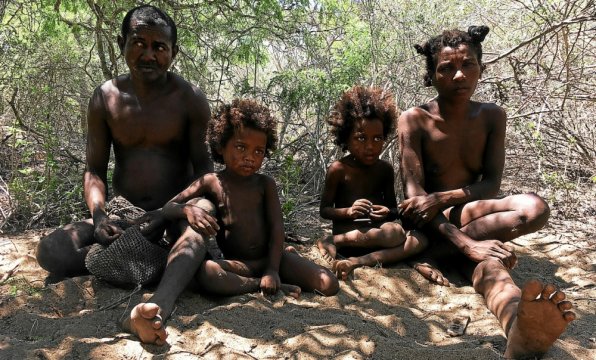MIKEA
It officially exists 18 ethnic groups in Madagascar but it turns out that subgroups, which can appear in different ethnic groups, are not formally listed. The number of these ethnic groups is unknown and there are even what one might call hidden peoples, like Mikea – the “forest people” – who indeed live reclusive in the dry forests of southwest Madagascar. This atypical population was compared to the Pygmies, because of their small size and their way of life (according to popular legend). To get fire for example, Mikea still use flint methods or twhich consists of rubbing dry branches between them. They hunt hedgehogs and porcupines, collect honey, then barter these resources for other goods with the other surrounding ethnic groups. The complex identity of the Mikea, hunter-gatherers with their forest lifestyle, therefore does not constitute a recognized ethnic group but is nevertheless classified as a separate identity like other ethnic groups.
Since the beginning of the years 60, the history of this forest people has aroused both the terror and the curiosity of many researchers, scientists and professors. About the Mikea, stories are told, false or true, but few have really met them. Surrounded by unfounded legends they have been nicknamed "the naked men" because they say they come and go all naked, that they are small, they have long hair, that they hide in the hollow of the trees and that they speak an incomprehensible language… Of course all of this is wrong, the Mikea are Malagasy from Masikoro language and custom, they have a normal size, their wardrobes are certainly very small, but men always have at least a thong and a piece of cloth, they often wear loincloths, and women have a cotton dress or a lamba.
Saha-Mangoky Medicinal Plant Knowledge Holders, they believe in a creative God named Zanahary and in the presence of a transcendental spirit. Many researchers have taken an interest in this people who live in harsh conditions on an extremely arid land.. They were able to understand that Mikea is in fact a generic term which indicates a group of people of Malagasy language and Masikoro customs, a group from southern Madagascar. Historically, for the sake of safety and freedom, certains Masikoro, a settlement in southern Madagascar from which the current Mikea originated took refuge in the forest. They fled the abuses perpetrated by their own sovereign. Living in small family groups, they moved constantly to escape the Sakalava rulers of Fiherenana or Bas-Mangoky to get slaves to swap them for cotton, guns or rum. Masters of their world, they live their lives as they want and know all the secrets to survive in the forest.
The Mikea live in secret in the thorny forest, consequently named "Mikea forest". The delimitation of this territory begins from the north of Toliara, à l'Ouest de Befandriana Sud, entre les rivières Mangoky et Manombo. Starting from Madiorano (50 km north of Toliara) to join Miary, A little bit, Ampasikibo, Andavadohaky, Antongo, Morombe, Befaefa, South Salary et enfin, we define a kind of circle which includes the Mikea territory. This area spans more than 70 km from north to south and from 30 km from west to east, either more than 2000 km² . This forest, whose mapping has never been completed, is thick, dense and yet almost without shade since the leaves of the trees growing there (Didiereacee in this case very representative) are rather thorns ! Mikea find many birds there, wild oxen, pit, wild cats, several species of lemurs and hedgehogs. They also harvest dark honey from wild bees. Armed with axes, wide heel spears, of a wooden pallet, of a net, of a basket, calabash and a container, they go to the forest to get food every day. They move around almost every day, over more than ten kilometers. After hunting and gathering, these foods will be eaten raw, grilled or cooked under the ashes.
This territory has no source, neither mother, neither well : Mikea therefore do not have fire receptacles because without water no pot is useful. So simmered dishes, soups or other porridge does not exist in the diet of this remarkable people. Only grilled or stewed or cooked dishes feed the Mikea, common foods such as cassava, corn and especially rice are absent in relation to the need to have water to cook them. The Mikea are therefore forced to a frugal diet : It is the pledge of their freedom and their independence, their isolation frees them from any state control…
The most remarkable fact, which marks the spirits, is the incredible adaptation of these people who manage not to drink water for days, weeks, see months… How do they do ? The answer to this question is through a vine called baboho : this yam whose tubers, big as the thigh, grow in the sand at the depth of a human arm. With tender and fragile flesh, a slightly milky translucent shade, the baboho are full of water. By eating them we drink as much as we eat, the liquid released from the pulp is fresh. By putting pieces on the embers you get a refreshing hot jelly that serves as breakfast.
But the reverse side of this wild and authentic side, like all the ancient peoples of our dear land, Mikea risks a sad end. They face, everyday under the pressure of modern city civilization. They started to become known by the first local but also foreign explorers and it is perhaps by the same way that they will disappear. Phagocytosed by a more global system, the modern world.


